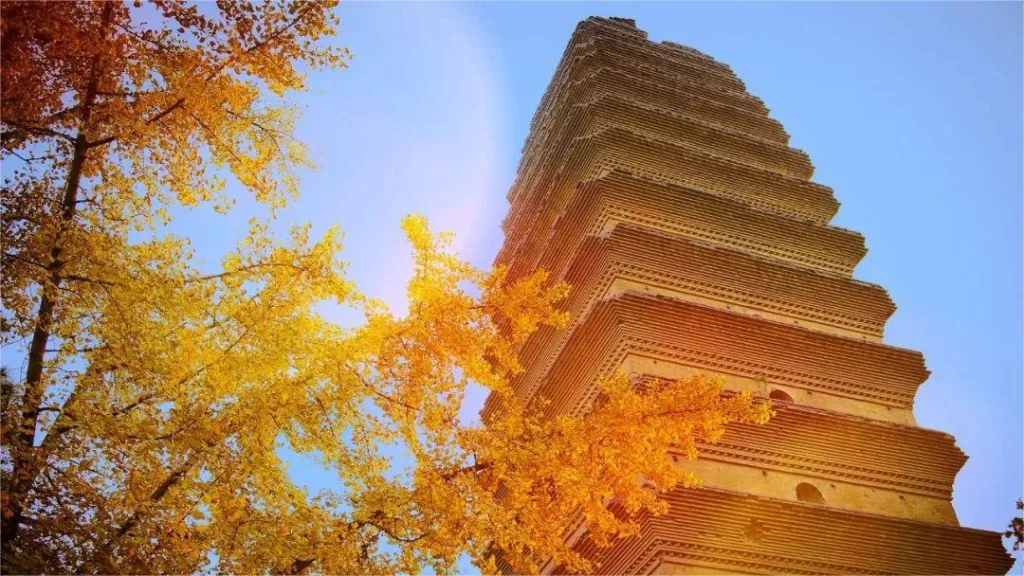6 Pagodes famosos em Xi'an


Xi’an, steeped in history and culture, is home to several famous pagodas that stand as testaments to its ancient heritage and architectural prowess. Each of these iconic structures tells a unique story, reflecting Xi’an’s rich tapestry of civilization and its enduring influence on Chinese history. From the towering Big Wild Goose Pagoda to the serene ambiance of the Small Wild Goose Pagoda, these pagodas showcase the city’s deep-rooted Buddhist tradition, artistic achievements, and architectural ingenuity.
Pagode do Grande Ganso Selvagem (大雁塔): One of Xi’an’s most iconic landmarks, the Big Wild Goose Pagoda resides within the confines of the Great Ci’en Temple. Initiated under the guidance of the revered monk Xuanzang, this pagoda was erected to safeguard the scriptures, Buddha statues, and relics brought back from India via the Silk Road. With its seven-tiered structure resembling a square pyramid, the pagoda boasts the distinction of being the oldest and largest extant brick pagoda of the Tang Dynasty. Within its confines, visitors can behold the Buddha statues, relics, and Sanskrit scriptures retrieved by Xuanzang, while each tier offers panoramic vistas of the ancient city of Chang’an. Notably, the southern entrance of the ground floor showcases the renowned steles inscribed with the “Preface to the Sacred Teachings of the Great Tang Tripitaka” and its accompanying commemorative inscription, both meticulously penned by the esteemed Chu Suiliang during the reign of Emperor Gaozong of the Tang Dynasty.
Pequeno Pagode do Ganso Selvagem (小雁塔): Nestled within the remnants of the Jianfu Temple, the Small Wild Goose Pagoda stands as another prominent Buddhist pagoda in Xi’an, erected to enshrine the Buddhist scriptures and relics brought back to China by the Tang Dynasty monk Yijing. Originally comprising fifteen tiers, the pagoda currently stands at thirteen tiers, reaching a height of 43.4 meters. Surrounded by tranquil environs, the pagoda exudes an aura of serenity and scenic beauty, with its “Morning Bell Chime of the Wild Goose Pagoda” renowned far and wide.
Xianyou Temple Pagoda (仙游寺塔): Situated at the mouth of Heishui Valley in Mazhao Town, Zhouzhi County, Xi’an, the Xianyou Temple Pagoda traces its origins to the first year of the Sui Dynasty’s Ren Shou era (601 AD). Comprising seven tiers and reaching a height of 30 meters, this pagoda adopts the characteristic features of a tower with densely tiered eaves. Adorned with a vaulted entrance on its southern façade, each tier of the pagoda also features a dedicated entrance gate. As one of the rare extant brick pagodas from the Sui Dynasty, the Xianyou Temple Pagoda holds profound significance for the study of Sui Dynasty pagoda architecture and the development of Buddhism during that era.
Xingjiao Temple Pagoda (兴教寺塔): Nestled within the premises of the Xingjiao Temple in the Duqu Street, Chang’an District, Xi’an, the Xingjiao Temple Pagoda serves as the funerary stupa for the relics of the Tang Dynasty monk Xuanzang and his disciples Kuiji and Yancong. Regarded as the oldest extant tower-and-pavilion-style pagoda in China, this architectural marvel bears witness to the propagation of Buddhism along the Silk Road to Chang’an and its subsequent influence on the Korean Peninsula. Designated as a UNESCO World Heritage Site in 2014, this pagoda holds significant importance in the history of Buddhist dissemination and Sino-Indian cultural exchange.
Baoqing Temple Pagoda (宝庆寺塔): Commonly known as the “Hua Pagoda” or “Hua Tower,” the Baoqing Temple Pagoda stands at the northern junction of Shuyuanmen Street within the Daming Gate vicinity in Beilin District, Xi’an. Constructed in the second year of the Jing Tai reign (1451 AD) of the Ming Dynasty, this hexagonal seven-tiered pagoda boasts a base length of 2.7 meters and a towering height of 23 meters. Characterized by its solid structure and brickwork adorned with dragon and phoenix motifs and brick-carved brackets, the pagoda also features stone-carved statues dating back to the Northern Wei, Sui, and Tang Dynasties, serving as invaluable artifacts for the study of ancient architectural techniques, stone carving artistry, Buddhist culture, and the urban development history of Xi’an.
Xiangji Temple Pagoda (香积寺塔): Located within the Xiangji Temple in Liujiacun Village, Fentou Town, 25 kilometers east of the county seat of Liquan County, Xi’an, the Xiangji Temple Pagoda, colloquially known as the “Bo Taohou Pagoda,” is an imposing seven-tiered brick pagoda believed to have been constructed between the late Tang Dynasty and the Song Dynasty. Standing 44 meters tall, with each side measuring 6.3 meters in length, this grand pagoda features an intricately designed tower-and-pavilion architecture adorned with brick pillars, platforms, railings, and hidden brackets.
Conhecimentos gerais sobre Xi'an